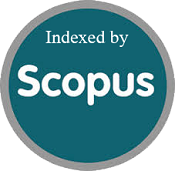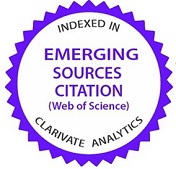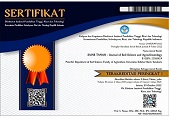Spatial-based analysis for risk erosion hazard in Jordan
Abstract
Keywords
Full Text:
PDFReferences
Aideh, M., & Sheta, W. (2025). Water Conservation in Jordan: Connecting the Dots for a Sustainable Future. In A. Sefelnasr, M. Sherif, & V. P. Singh (Eds.), Water Resources Management and Sustainability: Solutions for Arid Regions (pp. 361-378). Springer Nature Switzerland. https://doi.org/10.1007/978-3-031-80520-2_21
Al-Shabeeb, A. A.-R., Al-Adamat, R., Al-Fugara, A. k., Al-Amoush, H., & AlAyyash, S. (2018). Delineating groundwater potential zones within the Azraq Basin of Central Jordan using multi-criteria GIS analysis. Groundwater for Sustainable Development, 7, 82-90. https://doi.org/10.1016/j.gsd.2018.03.011.
Al-Sheriadeh, M. S., Husein Malkawi, A. I., Al-Hamdan, A., & Abderahman, N. S. (2000). Evaluating sediment yield at King Talal Reservoir from landslides along Irbid–Amman Highway. Engineering Geology, 56(3), 361-372. https://doi.org/10.1016/S0013-7952(99)00119-2.
Al-Wadaey, A., & Ziadat, F. (2014). A participatory GIS approach to identify critical land degradation areas and prioritize soil conservation for mountainous olive groves (case study). Journal of Mountain Science, 11(3), 782-791. https://doi.org/10.1007/s11629-013-2827-x.
Ali, A. A., Al-Abbadi, A. M., Jabbar, F. K., Alzahrani, H., & Hamad, S. (2023). Predicting Soil Erosion Rate at Transboundary Sub-Watersheds in Ali Al-Gharbi, Southern Iraq, Using RUSLE-Based GIS Model. Sustainability, 15(3), 1776. https://doi.org/10.3390/su15031776.
Alkharabsheh, H. M., Mwadalu, R., Mochoge, B., Danga, B., Raza, M. A., Seleiman, M. F., . . . Gitari, H. (2023). Revitalizing the Biochemical Soil Properties of Degraded Coastal Soil Using Prosopis juliflora Biochar. Life, 13(10), 2098. https://doi.org/10.3390/life13102098.
Alkharabsheh, M. M., Alexandridis, T. K., Bilas, G., Misopolinos, N., & Silleos, N. (2013). Impact of Land Cover Change on Soil Erosion Hazard in Northern Jordan Using Remote Sensing and GIS. Procedia Environmental Sciences, 19, 912-921. https://doi.org/10.1016/j.proenv.2013.06.101.
Andriyani, I., Indarto, I., Soekarno, S., & Pradana, M. P. (2024). Analysis of rainfall erosivity factor (R) on prediction of erosion yield using USLE and RUSLE Model’s; A case study in Mayang Watershed, Jember Regency, Indonesia. Sains Tanah Journal of Soil Science and Agroclimatology, 21(1), 10. https://doi.org/10.20961/stjssa.v21i1.63641.
Angulo-Martínez, M., & Barros, A. P. (2015). Measurement uncertainty in rainfall kinetic energy and intensity relationships for soil erosion studies: An evaluation using PARSIVEL disdrometers in the Southern Appalachian Mountains. Geomorphology, 228, 28-40. https://doi.org/10.1016/j.geomorph.2014.07.036.
Arabameri, A., Pradhan, B., & Lombardo, L. (2019). Comparative assessment using boosted regression trees, binary logistic regression, frequency ratio and numerical risk factor for gully erosion susceptibility modelling. CATENA, 183, 104223. https://doi.org/10.1016/j.catena.2019.104223.
Bonilla-Bedoya, S., López-Ulloa, M., Vanwalleghem, T., & Herrera-Machuca, M. Á. (2017). Effects of Land Use Change on Soil Quality Indicators in Forest Landscapes of the Western Amazon. Soil Science, 182(4), 128-136. https://doi.org/10.1097/ss.0000000000000203.
Borrelli, P., Panagos, P., Märker, M., Modugno, S., & Schütt, B. (2017). Assessment of the impacts of clear-cutting on soil loss by water erosion in Italian forests: First comprehensive monitoring and modelling approach. CATENA, 149, 770-781. https://doi.org/10.1016/j.catena.2016.02.017.
Borrelli, P., Robinson, D. A., Fleischer, L. R., Lugato, E., Ballabio, C., Alewell, C., . . . Panagos, P. (2017). An assessment of the global impact of 21st century land use change on soil erosion. Nature Communications, 8(1), 2013. https://doi.org/10.1038/s41467-017-02142-7.
Borrelli, P., Robinson, D. A., Panagos, P., Lugato, E., Yang, J. E., Alewell, C., . . . Ballabio, C. (2020). Land use and climate change impacts on global soil erosion by water (2015-2070). Proceedings of the National Academy of Sciences, 117(36), 21994-22001. https://doi.org/10.1073/pnas.2001403117.
Ebabu, K., Tsunekawa, A., Haregeweyn, N., Tsubo, M., Adgo, E., Fenta, A. A., . . . Poesen, J. (2022). Global analysis of cover management and support practice factors that control soil erosion and conservation. International Soil and Water Conservation Research, 10(2), 161-176. https://doi.org/10.1016/j.iswcr.2021.12.002.
Essa, S. (2004). GIS modeling of land degradation in Northern Jordan using Landsat imagery. Proceeding of the 20th ISPRS Congress, https://www.isprs.org/proceedings/xxxv/congress/comm4/papers/401.pdf
Farhan, Y., & Alnawaiseh, S. (2018). Spatio-temporal variation in rainfall erosivity over Jordan using annual and seasonal precipitation. Natural Resources, 9(6), 242-267. https://doi.org/10.4236/nr.2018.96016.
Farhan, Y., & Nawaiseh, S. (2015). Spatial assessment of soil erosion risk using RUSLE and GIS techniques. Environmental Earth Sciences, 74(6), 4649-4669. https://doi.org/10.1007/s12665-015-4430-7.
Farhan, Y., Zregat, D., & Farhan, I. (2013). Spatial estimation of soil erosion risk using RUSLE approach, RS, and GIS techniques: a case study of Kufranja watershed, Northern Jordan. Journal of Water Resource and Protection, 5(12), 1247. https://doi.org/10.4236/jwarp.2013.512134
Felix, F. C., Cândido, B. M., & Moraes, J. F. L. d. (2023). Improving RUSLE predictions through UAV-based soil cover management factor (C) assessments: A novel approach for enhanced erosion analysis in sugarcane fields. Journal of Hydrology, 626, 130229. https://doi.org/10.1016/j.jhydrol.2023.130229.
Heryani, N., Kartiwa, B., Rejekiningrum, P., Pramudia, A., & Sosiawan, H. (2023). Rainwater harvesting and water-saving irrigation for enhancing land productivity in upland rice cultivation. Jurnal Agronomi Indonesia (Indonesian Journal of Agronomy), 51(3), 378-388. https://doi.org/10.24831/jai.v51i3.50325.
Jordan Meteorological Department. (2025). Agricultural Climate Information. Jordan Meteorological Department. Retrieved May 25, 2025 from http://jometeo.gov.jo/
Jordan Ministry of Agriculture. (1994). The soils of Jordan. National Soil Map and Land Use project. Hunting Technical Services Ltd, and Soil Survey and Land Research Center, Amman, Jordan.
Ke, Q., & Zhang, K. (2022). Interaction effects of rainfall and soil factors on runoff, erosion, and their predictions in different geographic regions. Journal of Hydrology, 605, 127291. https://doi.org/10.1016/j.jhydrol.2021.127291.
Keesstra, S., Mol, G., De Leeuw, J., Okx, J., Molenaar, C., De Cleen, M., & Visser, S. (2018). Soil-Related Sustainable Development Goals: Four Concepts to Make Land Degradation Neutrality and Restoration Work. Land, 7(4), 133. https://doi.org/10.3390/land7040133.
Khan, A., & Rahman, A.-u. (2024). Spatial analysis and extent of soil erosion risk using the RUSLE approach in the Swat River Basin, Eastern Hindukush. Applied Geomatics, 16(3), 545-560. https://doi.org/10.1007/s12518-024-00567-6.
Li, C., Li, Z., Yang, M., Ma, B., & Wang, B. (2021). Grid-Scale Impact of Climate Change and Human Influence on Soil Erosion within East African Highlands (Kagera Basin). International Journal of Environmental Research and Public Health, 18(5), 2775. https://doi.org/10.3390/ijerph18052775.
Li, Z., & Fang, H. (2016). Impacts of climate change on water erosion: A review. Earth-Science Reviews, 163, 94-117. https://doi.org/10.1016/j.earscirev.2016.10.004.
Liu, J., Liang, Y., Gao, G., Dunkerley, D., & Fu, B. (2022). Quantifying the effects of rainfall intensity fluctuation on runoff and soil loss: From indicators to models. Journal of Hydrology, 607, 127494. https://doi.org/10.1016/j.jhydrol.2022.127494.
Luvai, A., Obiero, J., & Omuto, C. (2022). Soil Loss Assessment Using the Revised Universal Soil Loss Equation (RUSLE) Model. Applied and Environmental Soil Science, 2022(1), 2122554. https://doi.org/10.1155/2022/2122554.
Makhamreh, Z. M. (2019). Land degradation vulnerability assessment based on land use changes and FAO suitability analysis in Jordan. Spanish Journal of Soil Science, 9(2). https://doi.org/10.3232/SJSS.2019.V9.N2.05.
Martel, J.-L., Brissette, F. P., Lucas-Picher, P., Troin, M., & Arsenault, R. (2021). Climate Change and Rainfall Intensity–Duration–Frequency Curves: Overview of Science and Guidelines for Adaptation. Journal of Hydrologic Engineering, 26(10), 03121001. https://doi.org/10.1061/(ASCE)HE.1943-5584.0002122.
Montgomery, D. R. (2007). Soil erosion and agricultural sustainability. Proceedings of the National Academy of Sciences, 104(33), 13268-13272. https://doi.org/10.1073/pnas.0611508104.
Mousavi, S. R., Sarmadian, F., Angelini, M. E., Bogaert, P., & Omid, M. (2023). Cause-effect relationships using structural equation modeling for soil properties in arid and semi-arid regions. CATENA, 232, 107392. https://doi.org/https://doi.org/10.1016/j.catena.2023.107392.
Olika, G., Fikadu, G., & Gedefa, B. (2023). GIS based soil loss assessment using RUSLE model: A case of Horo district, western Ethiopia. Heliyon, 9(2), e13313. https://doi.org/10.1016/j.heliyon.2023.e13313.
Panagos, P., Borrelli, P., Poesen, J., Ballabio, C., Lugato, E., Meusburger, K., . . . Alewell, C. (2015). The new assessment of soil loss by water erosion in Europe. Environmental Science & Policy, 54, 438-447. https://doi.org/10.1016/j.envsci.2015.08.012.
Panagos, P., Lugato, E., Ballabio, C., Biavetti, I., Montanarella, L., & Borrelli, P. (2022). Soil Erosion in Europe: From Policy Developments to Models, Indicators and New Research Challenges. In R. Li, T. L. Napier, S. A. El-Swaify, M. Sabir, & E. Rienzi (Eds.), Global Degradation of Soil and Water Resources: Regional Assessment and Strategies (pp. 319-333). Springer Nature Singapore. https://doi.org/10.1007/978-981-16-7916-2_21
Rahman, M. M., Howladar, M. F., & Faruque, M. O. (2017). Assessment of soil quality for agricultural purposes around the Barapukuria coal mining industrial area, Bangladesh: insights from chemical and multivariate statistical analysis. Environmental Systems Research, 6(1), 24. https://doi.org/10.1186/s40068-017-0101-x.
Rashmi, I., Karthika, K. S., Roy, T., Shinoji, K. C., Kumawat, A., Kala, S., & Pal, R. (2022). Soil Erosion and Sediments: A Source of Contamination and Impact on Agriculture Productivity. In M. Naeem, J. F. J. Bremont, A. A. Ansari, & S. S. Gill (Eds.), Agrochemicals in Soil and Environment: Impacts and Remediation (pp. 313-345). Springer Nature Singapore. https://doi.org/10.1007/978-981-16-9310-6_14
Renard, K. G., Foster, G. R., Weesies, G. A., McCool, D. K., & Yoder, D. C. (1997). Predicting soil erosion by water: a guide to conservation planning with the Revised Universal Soil Loss Equation (RUSLE). US Department of Agriculture, Agricultural Research Service. https://www3.epa.gov/npdes/pubs/ruslech2.pdf
Rodrigo-Comino, J., Keesstra, S., & Cerdà, A. (2018). Soil Erosion as an Environmental Concern in Vineyards: The Case Study of Celler del Roure, Eastern Spain, by Means of Rainfall Simulation Experiments. Beverages, 4(2), 31. https://doi.org/10.3390/beverages4020031.
Ssewankambo, G., Kabenge, I., Nakawuka, P., Wanyama, J., Zziwa, A., Bamutaze, Y., . . . Tessema, B. (2023). Assessing soil erosion risk in a peri-urban catchment of the Lake Victoria basin. Modeling Earth Systems and Environment, 9(2), 1633-1649. https://doi.org/10.1007/s40808-022-01565-6.
Thapa, P. (2020). Spatial estimation of soil erosion using RUSLE modeling: a case study of Dolakha district, Nepal. Environmental Systems Research, 9(1), 15. https://doi.org/10.1186/s40068-020-00177-2.
Wischmeier, W. H., & Smith, D. D. (1978). Predicting rainfall erosion losses: a guide to conservation planning. Department of Agriculture, Science and Education Administration. https://www.ars.usda.gov/ARSUserFiles/60600505/RUSLE/AH_537%20Predicting%20Rainfall%20Soil%20Losses.pdf
Wolka, K., Tadesse, H., Garedew, E., & Yimer, F. (2015). Soil erosion risk assessment in the Chaleleka wetland watershed, Central Rift Valley of Ethiopia. Environmental Systems Research, 4(1), 5. https://doi.org/10.1186/s40068-015-0030-5.
Zhang, Y., Zhang, P., Liu, Z., Xing, G., Chen, Z., Chang, Y., & Wang, Q. (2024). Dynamic analysis of soil erosion in the affected area of the lower Yellow River based on RUSLE model. Heliyon, 10(1), e23819. https://doi.org/10.1016/j.heliyon.2023.e23819.
Ziadat, F. M., & Taimeh, A. Y. (2013). Effect of rainfall intensity, slope, land use and antecedent soil moisture on soil erosion in an arid environment. Land Degradation & Development, 24(6), 582-590. https://doi.org/10.1002/ldr.2239.











.png)





